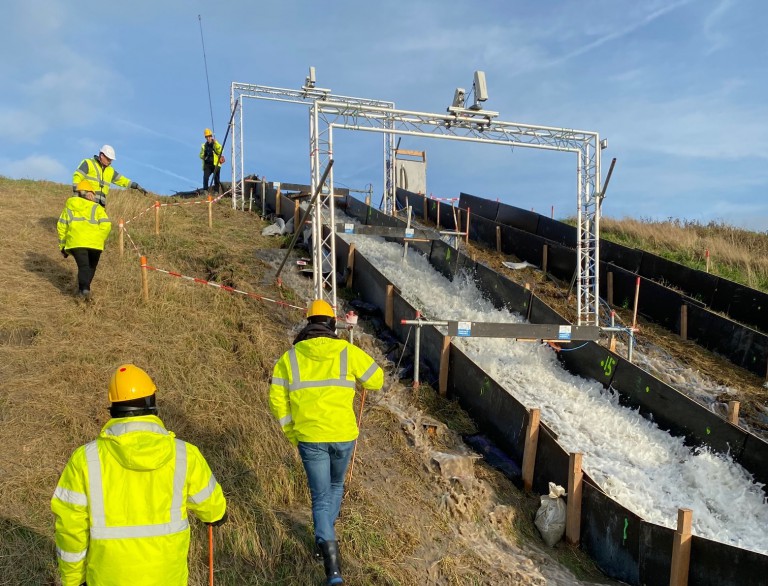Impact of repair measures, vegetation and animal burrows on erosion resistance
- 02 December 2021
- Francien Horrevorts
- Flood Defence
What is the impact of elements such as the presence of vegetation or repair measures on our flood defences? How do they affect the amount of erosion of the levee cover and ultimately the levee strength? These are some of the questions the Polder2C’s partners have been testing with overflow tests.
Overflow tests
The overflow generator is a set-up that can simulate overflow of the levee which occurs when the water level of the river exceeds the crest of the levee. The water is supplied to the overflow generator via pumps. Water continuously flows down the slope of the levee, usually via a demarcated test strip. During the experiment the water level, water velocity and pump discharge can be changed and measurement devices are used to monitor the tests and state of the levee. Typically, an experiment takes several hours or until the damage that occurs threatens the levee stability.
Third series of overflow tests
After two series of overflow tests performed in November 2020 and February 2021, recently the third series has started. This series follows up on some earlier activities that have been done in the Living Lab. This series of tests is designed to learn more about the impact of repair measures, different kinds of vegetation and animal burrowing on erosion.

Repair Measures
The first overflow tests resulted in levee damage, which allowed for trying out several kinds of repair measures. Among them were the application of so-called rock bags, use of standard clay, clay with a seed mix for vegetation, a reinforced turf mat and a light translucent geotextile. Most of these techniques have been applied in the spring of 2021. A lot of insight has already been gathered about applying the measure. But how well can they withstand continuous water overflow and how do they compare? To answer these questions these measures are put to the test.
Types of vegetation
The type of vegetation is another important factor that influences the levee strength and the amount of erosion in case of water overflow. To understand the influence of the vegetation on erosion and levee stability better, several strips of the levee with varying types of vegetation are included in the experiment. Strips with a well-developed grass cover, treatment of marsh sods, reed near the toe of the levee and a strip with young vegetation will be compared.
Animal Burrowing
A final topic that is included in this series of tests is animal burrowing. Over the course of the Polder2C’s project, more and more attention is paid to animal burrowing. This research was focused on locating animal burrows and how the burrows are interconnected in the levee. The overflow test is done in order to assess the impact of the burrows of different animals on levee stability and to compare their impact. Preliminary results are somewhat alarming…
Results
At this stage it is too early to draw any definite conclusions on the overflow tests. So far, it has become clear that although a repair measure can look fine, this does not necessarily result in adequate strength. However, more research and analysis into the data is needed. These results will be shared later.
